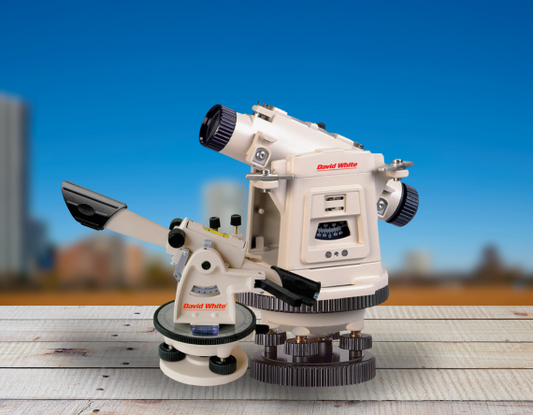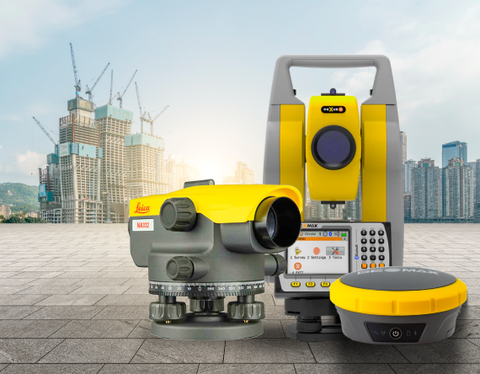In the construction industry, laser levels are essential tools, known for their precision and efficiency. Whether you're certain you need a specific type, like a rotary laser level for large projects, or you're exploring your options, understanding the variety available can enhance your project outcomes. This guide is designed to help both seasoned professionals and those new to laser levels. We'll cover the key types—point, line, cross-line, rotary, and slope lasers—explaining their unique features and applications. Whether you’re fine-tuning your choice or starting from scratch, our insights will ensure you select the right laser level for your needs without feeling overwhelmed or under-informed.
Types of Construction Laser Levels
With so many options available, selecting the best laser level for your project can seem difficult. Here's a breakdown of the most common types to help you decide:
Point Laser Levels:
Compact and handy, these project one or more red or green laser dots. Think of them as digital plumb bobs, ideal for determining square for footers, foundations, etc., and for establishing plumb. Their small size makes them perfect for tight spaces and quick measurements, like hanging shelves or checking post placement.
Line Laser Levels:
Unlike a Point Laser Level, these are used for different purposes. The Line Lasers project horizontal and/or vertical laser lines. This allows you to level entire surfaces, like countertops or floors, or ensure perfect alignment for drop ceilings, cabinets, and other linear components. Many line lasers include self-leveling technology, automatically adjusting the beam for precise results without manual fuss.
Cross-Line Laser Levels:
Cross-Line Laser Levels are a variation of the Line Laser Levels. They project a horizontal and vertical line simultaneously, creating a laser crosshair on your workspace. This versatility makes them ideal for a wide range of tasks, from laying out partitions to installing drywall tracks or aligning fixtures.
Rotary Laser Levels:
Designed for large-scale outdoor projects, the Rotary Laser Levels emit a 360-degree horizontal plane of laser light. Perfect for long-distance leveling tasks like driveways, foundation excavation, or establishing elevations across vast areas. These often feature a much greater range than other types.
Slope Lasers:
Slope Lasers can be used as a basic Rotary Laser Level but they primarily are used for tasks that require precise grading and slope measurement, such as in road construction, landscaping, and drainage projects. They allow operators to set a specific slope or grade, ensuring consistent angles over large areas. Single slope lasers provide a slope in one direction, while dual slope lasers can handle slopes in two directions simultaneously, making them ideal for complex grading tasks like creating proper drainage systems or leveling large surfaces with precision.
Factors to Consider When Making the Purchase
Here are some key considerations to ensure you choose the perfect professional laser levels for your construction projects:
Accuracy
Laser level accuracy is specified in plus or minus units over a defined distance. This indicates how much the laser beam may deviate from the perfect level over that distance.
Manual vs. Self-Leveling Laser Levels:
Virtually all construction laser levels today are self-leveling, utilizing internal mechanisms to automatically establish and maintain a precise level line, making them highly accurate and user-friendly. Even those that require some manual adjustment still incorporate self-leveling features that fine-tune the alignment once the device is roughly positioned. This ensures maximum accuracy with minimal effort.
Range
Match the range of your laser level to your project size. For small indoor jobs, a 100-foot (30m) range level might suffice. Larger projects or outdoor environments with long sightlines may require a level with a range exceeding 330 feet (100 meters).
Durability
Construction sites can be tough on equipment. Look for models with robust housing and impact-resistant build to withstand dust, moisture, and potential drops or bumps. Consider features like dustproof and waterproof ratings for added protection in harsh conditions. Professional-grade equipment typically offers these enhanced durability features.
Ease of Use
When selecting a construction laser level, ease of use is an important factor to consider. A user-friendly experience is essential, encompassing intuitive controls and simple interfaces on the laser itself. Some lasers come with remotes for operating the device, especially for single and dual-slope grade lasers, allowing for easy adjustments from a distance. Laser detectors also play a significant role in usability, with advanced models featuring longer detection windows and more detailed readouts. These enhancements make it easier to achieve precise measurements quickly, ensuring efficiency and accuracy on the job site.
(Conclusion)
By carefully considering these factors, types, and benefits, you can select a construction laser level that perfectly aligns with your project requirements and maximizes your productivity on the job site. In addition, our seasoned professionals at James River Laser and Equipment will provide you with expert advice so you can make the best decision.













